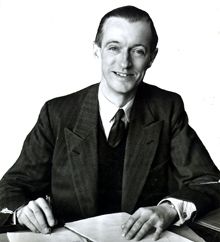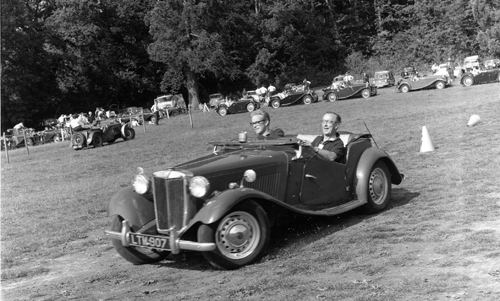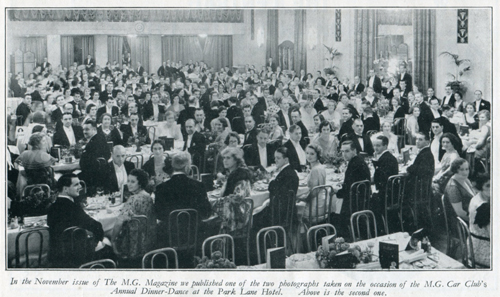History of the MG Car Club: Part 2

 We continue with Part 2 of the multi-article series on the History of the MG Car Club UK. This article covers the year 1932 when John Thornley was Club Secretary.
We continue with Part 2 of the multi-article series on the History of the MG Car Club UK. This article covers the year 1932 when John Thornley was Club Secretary.
A FORMATIVE YEAR 1932 – JOHN THORNLEY
Forgive me if I do not pick up the threads of these chronicles of the MG Car Club from the exact point at which Harold Hastings left off. I will start in the middle of 1931 when, at the July Open Shelsley Meeting, the Club provided a car park for members for the first time. This, together with tea in the marquee after the climb, was the forerunner of what is now one of the Club’s traditions. Nearly 200 teas were consumed and, whilst the percentage of gate crashers was not computed, it could only have been very small indeed, as every single individual in the marquee seemed to know at least half a dozen others, which resulted in a thoroughly matey affair.

The following weekend the Club registered its one and only really serious failure. An immense amount of care, time and trouble had been expended in organising a trial in the Peak District. Many of the best known hills were to be used, including Litton Slack and Jenkins Chapel, but the entry was so uninspiring that the event was abandoned.
In the February of 1932 there was held the second annual dinner, also at the Mecca. Well do I remember the beginning of that party. It was apparently a new experience to many of those present, who were used to Club dinners on the grand scale, to go to a Club dinner which was not held at either the Park Lane (London), the Cafe Royal or one of the usual rendezvous, but as they arrived they were obviously wondering what sort of a ‘do’ it was to which they had been brought. They were soon to discover. The party warmed up with very great rapidity and by the time dinner was over and the floor cleared for dancing, things were in full swing. In the course of a recent record attempt on the ‘Magic Midget’, George Eyston had put in an exceedingly fast lap, only to find that the timekeepers had not done their stuff. The scene was accordingly re-enacted after dinner on the dance floor. George Eyston himself, sitting backwards astride a small chair, did several laps of the dance floor, ‘timed’ by Mr H.D. Parker of Shell Mex, who, in this farce, was cast as Colonel Lloyd-Parker, the whole production being ‘under the personal direction of Mr Cecil Kimber’.

On May 7, 1932, was held the first Abingdon–Abingdon. In later years this trial has gone from strength to strength, until it now appears in the year’s calendar as an undoubted classic. A rare array of trophies attracted an entry of 46.
Starting from the MG Car Company’s works at Abingdon, the route led through many of the famous Gloucestershire hills and returned to the works at Abingdon, where the company had pushed the boat out to the tune of a first class tea for all competitors, friends, organisers, and the like. The MG Challenge Trophy for the best MG Car Club member was won by W.G. Everitt, who has since raced MGs with great success, and has been associated with the road racing circuit at Crystal Palace. The cup for the best visitor was presented by Mr W.E.C. Watkinson to K.W. Bear in a Bugatti. The University Motors Trophy for the best under 1,100c.c. car was won by E.W. Deeley, and we, the organisers, had been so short-sighted in the preparation of the regulations that there was a tie for the P.J. Evans Ltd. Cup for the best over 1,100 c.c. car. This went jointly to H.H. Sewell and E.S. Barnes.
Shelsley appeared again on June 25, 1932 and shortly after, at the end of July, the membership reached 200. The 200th member was no less a man than Maurice Toulmin, though why he was not in the first 50 nobody has yet been able to discover.

In September, 1932, Alan Hess took over the secretaryship and, despite a very busy and enterprising year, the balance sheet published at this time showed the very satisfactory surplus of just over 50 pounds.
John Thornley played a leading role in both the MG Car Company and the MG Car Club. When five young men met in October 1930 to form a Club for MG owners the youngster who offered to act as its founding honorary secretary was John Thornley, a 21 year old student articled to one of the leading London accountancy firms who had recently bought an M Type Midget.
The infant MGCC Committee instructed him to seek approval from Cecil Kimber at Abingdon and this he did so effectively that the great man pledged his unstilted support; it marked the beginning of a happy relationship between Club and Company that was to span almost half a century.
Thornley himself wanted to escape the stuffed shirt City atmosphere and his energy and enthusiasm must have impressed the MG boss, for a year later he was given a full time job at Abingdon as a service department interviewer. Within weeks the service manager was moved to another post and Thornley found himself carrying the can for two not very talented successors. Ironically he had so much work to do that he had to resign his MGCC post! In 1933 he was appointed Service Manager.
As an army reservist, he was called up on the outbreak of war in 1939 and found himself shouldering considerable responsibilities in the Royal Army Ordnance Corps where he rose to the rank of Lieutenant Colonel.
Returning to Abingdon after the war he became MG sales and service manager. With MGs export sales rocketing, the parent Nuffield Organisation recognised this dynamic individual as a man who got things done, and appointed him assistant general manager of both the MG Car Company and Riley Motors when Riley production moved to Abingdon in 1949. Three years later he had become General Manager of the two companies.
He was now under intense pressure to build enough MGs to satisfy the ever growing demand of the time – a demand that surged higher when the MGA was announced in late 1955 and when Austin-Healeys replaced Rileys on the Abingdon assembly lines.
Thornley’s keen interest in motor sport had never wavered. In the1930s he had competed in club events whenever he could find the time, and from 1936 to 1938 he managed the famous Crackers and Musketeers works trials teams.
The MGCC was restarted after the war in mid-1947 and at the end of the year Thornley took over his old position again as general secretary.
John was the one man who stood out amongst the grey-faced nonentities of the BMC management as a warm blooded human being, well known in the motor sporting world and a staunch advocate of works participation. He was responsible for the formation of the BMC Competitions Department at Abingdon in 1955, and in 1958 he became Chairman of the MGCC, a position he held for 22 years.
In the late 1950s a serious childhood illness returned, causing major surgery and a brave but long convalescence, which finally forced him to retire from MG in 1969. He returned to the fray to do battle against the closure of Abingdon by British Leyland without success.
NAMGAR would like to thank Andy Knott, Editor, Safety Fast! for his kind permission to re-produce this article.

